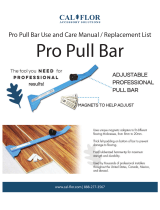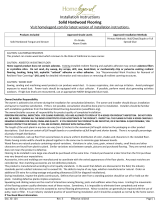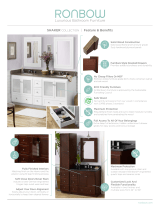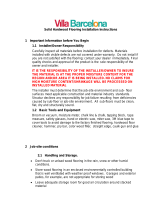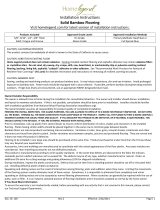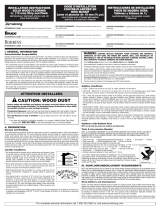Page is loading ...

Meritage
Installation Guide
(888) 788-2254
www.CaliBrands.com
Engineered Hardwood Flooring

Questions? (888) 788-2254
www.CaliBrands.com
Meritage Flooring Installation Guide
The Collection
Flooring Systems
Flooring Accessories
Extra Wide T&G
9-1/2” Wide
Plank Dims:
Random length up to 86-3/5”
9-1/2” W x 3/5” H
Quarter Round 9/16” Stair Nosing9/16” Reducer 9/16” T-Molding
9/16” Threshold

Questions? (888) 788-2254
www.CaliBrands.com
Meritage Flooring Installation Guide
Before you begin installation, remember to P.A.C.E. yourself with the checklist below. Full installation
instructions and maintenance guidelines can also be found online at www.CaliBrands.com
Pre-Installation
P ACE
EXPANSION
GAPS
Engineered ooring can be used in areas ranging from
30% to 55% relative humidity.
30-55% rH
5/8” Expansion Gap
5/8” Spacer
Baseboard
PA C E
CONTROL
ENVIRONMENT
Make sure the suboor is at, level, clean and free of debris.
New concrete must be cured for at least 60 days. Test the
suboor moisture prior to installation and apply an
appropriate moisture barrier. CALI recommends Titebond®
531+ on concrete suboors. Although, other moisture
barriers are available.
MOISTURE
BARRIER
Use a Moisture Barrier on Concrete
PA CE
ACCLIMATE
FLOORING
For Engineered ooring, lay boxes on the oor and only open
box ends as shown above.
Acclimate your oor as close to
the installation area as possible, for 72 hours in normal
living conditions.
Acclimate Your Engineered Flooring For 72 Hours
PACE
PREPARE
THE SUBFLOOR
Leave at least 5/8” expansion spaces between ooring and ALL
vertical objects (walls, cabinets, pipes, etc.) Large ooring runs
may require additional expansion space. For oating oors, use
transition moldings between rooms and doorways 3ft. or less.
Undercut door jambs and casings to provide adequate
expansion space. Do not screw or nail cabinetry or other
permanent xtures to a oating oor.

Questions? (888) 788-2254
www.CaliBrands.com
Meritage Flooring Installation Guide
Pre-Installation
Prepare Job Site, Acclimation, Control Subfloor Moisture, Environmental Conditions
Proper installation and maintenance are key elements in achieving best flooring results. It is the responsibility of the
installer/owner to follow all guidelines provided by CALI for success. Please read through this document
completely, additional installation materials such as videos, illustrations and more can also be found at
www.calibrands.com.
Important Pre-Installation Notes
Note: Flooring not used for its intended purpose will not be covered under warranty.
The following information provided by CALI is intended to serve as a reference guide only. Please carefully read CALI’s
installation, maintenance and warranty documentation prior to installation. Follow the National Wood Flooring Association
(NWFA) Installation Guidelines when installing your floor.
CALI offers in house technical support as a courtesy to our customers. Consult with one of our flooring experts to find
answers to your specific installation questions unique to your application.
Contact us by email: customerservic[email protected]; or by phone: 1(877) 237-2254 ext. 2.
• Determine the best installation method that suits your application. CALI floors may be Floated (not secured to the
subfloor), Glued, or Nailed. Follow the instructions designated for the most suitable installation method for your project.
• Upon ordering of wood floor material consider adding an additional 8% to allow for cutting waste (5%) and grading
allowance (3%).
• CALI flooring is manufactured in accordance with accepted industry standards, which permit manufacturing, grading
and natural deficiencies not to exceed 5%. If more than 5% of the material is unusable, do not install the flooring.
Immediately contact the distributor/retailer from which the flooring was purchased. No claim will be accepted for
materials with visible defects once they are installed. Installation of any material serves as acceptance of the material
delivered.
• Installer/Owner assumes all responsibility to inspect all flooring before installation. Boards deemed unacceptable in
appearance can be placed in closets, near walls or simply not be used. Pieces with glaring defects that can be seen
from a standing position should be cut off or not be used as use constitutes acceptance. The use of putty, filler sticks
or markers to touch-up flooring during installation is considered
normal practice.
• Because wood is a natural product, natural variations in color may
occur within and between individual flooring planks. To visualize
the range of colors within the flooring style you are considering,
compare your samples to the photos on our web site. During
installation, work from several cartons at a time to achieve a
uniform appearance across the entire floor. Mix and mingle planks
when dry laying the floor for maximum aesthetic appearance. Blend
moldings to planks that have similar color. Natural variations in
color are not covered under warranty.
• This flooring is not compatible with radiant heat. Damage caused
by or resulting from installation over radiant heat systems is not
covered under warranty.
• It is the responsibility of the installer/homeowner to determine if the job site conditions, environmental conditions and
sub-floor are acceptable for the installation of CALI flooring. Prior to installation, the installer/owner must determine that
the jobsite meets or exceeds all applicable National Wood Flooring Association’s Installation Guidelines. CALI does
NOT warrant against failure resulting from or connected with subfloor, job site damage, or environmental deficiencies
after installation.
• CALI makes no warranty or guarantee of the quality of the chosen installer’s work or of a particular installation
performed by him or her. CALI disclaims all liability for any errors or improprieties in the installation of its products by
an installer. Please contact the National Wood Flooring Association (800-422-4556) to find a certified installer in your
area, or for more information on installation.
• Controlling flooring moisture content is important for success. Due to the fact that all hardwood flooring is
hygroscopic; its size and shape changes naturally with the absorption or release of moisture. The amount
of movement varies depending on the preventative steps taken at the time of installation (i.e. acclimation,
moisture barrier application, etc.) and the stability home environment thereafter. Care should be taken to control
fluctuating levels of moisture indoors.

Questions? (888) 788-2254
www.CaliBrands.com
Meritage Flooring Installation Guide
Pre-Installation
• Cali Hardwoods will perform best when the indoor environment is controlled to stay within a temperature range of 60° to
80°F and 30% to 55% humidity. Humidity levels below 30% and above 55% highly increase the probability of movement
in the floor leading to such issues as gapping, cracking, cupping, warping, checking and veneer delamination. In some
climates, the use of a humidification/dehumidification system may be required to maintain proper humidity levels.
• Floor noise is normal and will vary from one installation type to the next. Occasional noise is due to structural movement
and may relate to sub-floor type, flatness, deflection, and/or related to the fasteners, changes in environmental
conditions, relative humidity and the amount of topside pressure applied to the flooring. For these reasons floor noise is
not considered a product or manufacturer defect.
• CALI engineered flooring is intended for installation above, on or below grade. For optimal performance below grade,
the floating method is highly recommended.
Prior to Installation of CALI Flooring
Job Site Prepartion
Prior to installation, it is the installer’s responsibility to determine that the jobsite, environment and subfloor conditions all
meet the requirements of the National Wood Flooring Association. Do not deliver flooring to jobsite until the building has
been enclosed with windows and doors, all cement, plastering, and other “wet” work has been completed, and a consistent
room temperature has been reached. Confirm proper drainage exists around the structure. Lack of moisture protection can
allow excessive water or moisture to penetrate basement walls, flow beneath concrete slabs, basement floors, and into crawl
spaces. In crawl spaces, exposed earth must be fully covered with minimum 6-mil polyethylene sheeting. Crawl space vents
must be open. A moisture retardant such as 6 mil polyethylene film must be placed in crawl spaces. Heating units or non-
insulated ductwork close to the flooring or subfloor may cause “hot spots” which must be eliminated prior to installation.
During installation, it is the installer’s responsibility to document all jobsite conditions and measurements including the
installation date, flooring moisture content, site relative humidity, temperature, and subfloor moisture content. This information
must be retained by the installer and left with the property owner as a permanent record. For a complete list of points to
address prior to installation, refer to the NWFA’s Jobsite Checklist.
Subfloor Requirements
General: Subfloor must be structurally sound and meet all NWFA guidelines. All subfloors must be flat to a tolerance of 3/16”
in a 10’ radius. Use appropriate leveling products for correcting subfloor deficiencies. Subfloor surfaces must be smooth,
clean, dry and free of contaminants that would interfere with an adhesive bond. All subfloors should be tested for moisture
content (see “Subfloor Moisture Testing”). If high moisture readings are found, identify the moisture source and correct the
problem before installation. Do not install flooring directly over floor joist without proper subflooring.
Appropriate Wood Subfloors Materials:
• CDX Exposure 1 plywood minimum 5/8-inch thick
• OSB Exposure 1 subfloor panels minimum 23/32-inch thick rated PS 2-92 or PS 1-95
• Solid-board subflooring should be 3/4-inch x 5-1/2-inch (1-inch x 6-inch nominal), Group 1 dense softwoods, No. 2
Common, kiln dried
Acceptable Subfloor Thickness Requirements:
Joist System Spacing (inches on center) Minimum Thickness Plywood Minimum Thickness OSB
12-inches to 16-inches 5/8-inch 23/32-inch
16.1-inches to 19.2-inches 23/32-inch 7/8-inch
19.3-inches to 24-inches 7/8-inch 1-inch
Concrete Subfloors: Subfloor must meet all above requirements. Concrete must be fully cured and at least 60 days old.
Concrete must be free of dirt, oil, paint, old adhesive, wax, sealers and curing agents. Concrete that is not properly leveled
can cause improper adhesive transfer, hollow spots, and squeaks. Sand or grind down high spots. Level low spots with
appropriate leveling material; allow extra drying time for the leveling compounds. Test subfloor moisture content. To minimize
moisture transfer from the slab, apply: Titebond 531+ Moisture Control System.

Questions? (888) 788-2254
www.CaliBrands.com
Meritage Flooring Installation Guide
Moisture Testing Subfloor
General: Test the subfloor for moisture content before installation. If high moisture readings are found, identify the moisture
source and correct the problem. Extend acclimation time and increase ventilation until the proper conditions have been met.
Apply a moisture barrier. Please note that test results are only applicable the day of testing and will not ensure that moisture will
not fluctuate with seasonal changes. Regardless of subfloor moisture content, the use of a moisture/vapor barrier is required
for all installations. CALI does not warrant against moisture related problems.
Wood Subfloors: Wood Subfloors: Use moisture meter to test wood subfloor moisture content. If results show moisture vapor
at or exceeding 12%, determine its source and correct problem. Do not install the floor without a vapor barrier. CALI always
recommends using a moisture/vapor barrier, especially if the moisture content of the flooring and subfloor vary greater than 3%.
Concrete Subfloors: Concrete subfloors must be tested for moisture vapor pressure in more than one place for consistent
readings. If test results show moisture vapor exceeds the minimum requirements below, do not install the floor without an
impermeable vapor retarder with a perm rating of less than .13 designed to permanently block this moisture.
• Calcium Chloride Test (ASTM F 1869): Maximum vapor emissions cannot exceed 3lbs/1000SF in 24 hours
• Tramex Concrete Moisture Encounter: Moisture readings should not exceed 4% on upper scale
• In-Situ Probe Method (ASTM F 2170): Relative Humidity levels should not exceed 75%
Moisture Testing Wood Floor
Use a reliable moisture meter that will accurately read the specific wood species being installed. Examples of acceptable
moisture meters include Delmhorst or a Lignomat SDM. If needed contact moisture meter manufacturer to verify settings for
specific species being installed.
Moisture Barrier Requirements
General: Unexpected changes to subfloor moisture content may cause dimensional changes to the floor. To ensure a lifetime
of satisfaction, it is strongly recommended that CALI flooring be installed over a moisture barrier or vapor retarder (following
manufactures guidelines) per the following specifications:
Wood Subfloors: For best results, use a moisture barrier/vapor retarder with a perm rating between 0.7 and 50 when tested
in accordance with ASTM E-96 Method A. Install as recommended by the manufacturer. Examples of acceptable moisture
barriers for wood subfloors include: Asphalt laminated paper (UU-B-790a, Grade B, Type I, Style 1a.) and: Asphalt-saturated
kraft paper. Due to the installation requirements for Meritage the above is only applicable when floating the floor. If nailing
the wood flooring adhesive will act as your moisture/vapor barrier.
Concrete Subfloors: For concrete applications, a moisture barrier/vapor retarder should be chosen based on concrete
moisture content. For unlimited moisture protection, CALI recommends the use of Titebond® 531+ Moisture Control System.
Install as recommended by the manufacturer.
Acclimation & Conditioning of CALI Flooring
The goal of acclimation is to allow the moisture content (MC) of the flooring to fully adjust to its new surroundings before
installation.
• Determine Normal Living Conditions - Ideal interior environmental conditions vary from region to region and job site to
job site. It is the installer’s responsibility to know what the “ideal” climate conditions are and customize the acclimation of
the floor around those conditions. For a general view of moisture content averages by region, see the map below.
• Control Home Conditions Accordingly - Acclimation should occur at normal living conditions. Before opening the
cartons, the indoor environment should reflect the room temperature and relative humidity levels expected to be present
before, during, and most importantly, after installation. Operate temperature / humidity control systems as normal. Allow
normal ventilation through rooms.
For Meritage Engineered Hardwood Flooring: CALI recommends simply opening the ends of each box and breaking the
shrinkwrap covering the flooring planks.
• Acceptable Areas for Acclimation - Acclimate the flooring as close to the center of the installation area as possible. Do
not store flooring next to outside walls, in direct sunlight, near air vents or under conditions that don’t reflect the normal
home environment. Garages, and exterior patios, for example, are not acceptable areas to store wood flooring during
acclimation.
• Determine Appropriate Acclimation Time Frame - CALI engineered hardwood flooring should be allowed to acclimate
on the job site for 72 hours.
Pre-Installation

Questions? (888) 788-2254
www.CaliBrands.com
Meritage Flooring Installation Guide
Optimum Flooring Moisture Content (%) by U.S. Region
This map is provided by the NWFA and relates to all hardwood flooring species. For each region, the average equilibrium
moisture content (EMC) for hardwood is identified for both January and July. The EMC is the MC (%) that the floor will reach
once it has fully acclimated to its environment. This is also the optimum MC for installation, and will provide a general idea of
what acclimation measures to take. In each pair of figures, the first number is the average EMC during January; the second
is the average EMC during July.
Note: Actual moisture content conditions in any location may differ significantly from these numbers. This map cannot be
reliably used as a basis for installation. The most reliable moisture-content numbers can be obtained at the job site.
Take moisture content readings of the flooring, subfloor and relative humidity to be sure.
To better understand the specific acclimation requirements for your home, refer to the chart below for correlations between
relative humidity (RH), temperature, and flooring moisture content (%). Referencing the weather conditions in your area, find
the combination of temperature and RH on the chart. This value represents the flooring moisture content to achieve during
acclimation for best results.
Values within chart’s shaded area represent environments with relative humidity (RH) and temperature capable of
maintaining the delivered moisture content of 6% to 10%. These are optimum conditions for maximum flooring stability. For
environments outside of this range, allow more time for acclimation. Depending on your local in-home conditions, the use of
humidification/dehumidification equipment may be recommended to maintain proper in-home environment.
Pre-Installation

Questions? (888) 788-2254
www.CaliBrands.com
Meritage Flooring Installation Guide
MOISTURE CONTENT OF WOOD
AT VARIOUS TEMPERATURES AND RELATIVE HUMIDITY READINGS
30 1.4 2.6 3.7 4.6 5.5 6.3 7.1 7.9 8.7 9.5 10.4 11.3 12.4 13.5 14.9 16.5 18.5 21.0 24.3 26.0
40 1.4 2.6 3.7 4.6 5.5 6.3 7.1 7.9 8.7 9.5 10.4 11.3 12.4 13.5 14.9 16.5 18.5 21.0 24.3 26.0
50 1.4 2.6 3.7 4.6 5.5 6.3 7.1 7.9 8.7 9.5 10.4 11.3 12.4 13.5 14.9 16.5 18.5 21.0 24.3 26.0
60 1.3 2.5 3.6 4.6 5.4 6.2 7.0 7.8 8.6 9.4 10.2 11.1 12.1 13.3 14.6 16.2 18.2 20.7 24.1 26.8
70 1.3 2.5 3.5 4.5 5.4 6.2 6.0 7.7 8.5 9.2 10.1 11.0 12.0 13.1 14.4 16.0 17.9 20.5 23.9 26.6
80 1.3 2.4 3.5 4.4 5.3 6.1 6.8 7.6 8.3 9.1 9.9 10.8 11.7 12.0 14.2 15.7 17.7 20.2 23.6 26.3
90 1.2 2.3 3.4 4.3 5.1 5.9 6.7 7.4 8.1 8.9 9.7 10.5 11.5 12.6 13.9 15.4 17.3 19.8 23.3 26.0
100 1.2 2.3 3.3 4.2 5.0 5.8 6.5 7.2 7.9 8.7 9.5 10.3 11.2 12.3 13.6 15.1 17.0 19.5 22.9 25.6
5 10 15 20 25 30 35 40 45 50 55 60 65 70 75 80 85 90 95 98
Relative Humidity (percent)
Chart taken from Wood Handbook: Wood as an Engineering Material (Agriculture Handbook, 72). Forest Products Laboratory, U.S. Department of Agriculture
Here is an example of how to use the Moisture Content of Wood chart:
• My home is normally and currently maintained at an average temperature of: 70°F
• My home is normally and currently maintained at an average relative humidity of: 40% RH
• The combination of 70°F and 40%RH on the chart shows that the floor should be acclimated moisture
content of: 7.7%
• The value of 7.7% MC falls within the shaded area on the chart.
Continue to acclimate the flooring until the flooring moisture content varies less than 3% from the subfloor (e.g. if subfloor
has a moisture content of 6%, the maximum moisture content of the flooring should be 9%). Testing of the flooring, subfloor
and relative humidity of the job site can determine this (see Subfloor & Flooring Moisture Testing) sections.
Note: Acclimate engineered hardwood flooring for a minimum of 48 hours and a maximum of 72 hours. Not properly
acclimating wood flooring may cause excessive expansion, shrinkage, dimensional distortion or structural damage. The
worst-case scenario is one in which wood flooring is stored outside of the area in which the wood is to be installed.
Acclimation is the responsibility of the installer/homeowner.
Pre-Installation

Questions? (888) 788-2254
www.CaliBrands.com
Meritage Flooring Installation Guide
Installation of CALI Flooring
General Guidelines - All Installation Types
• Follow CALI Care & Maintenance Guidelines to keep your floor looking its best after installation.
• Save extra flooring for future repairs.
• Do not install permanent of fixed cabinetry if you are using the floating method to install. This will automatically void
structural warranty. If gluing or nailing the floor this is still not a recommended practice, however, it will not void
warranty.
• Floor should be installed from several cartons at the same time to ensure good color, shade and appearance.
• Most installation failures result from jobsite moisture. Do not deliver flooring to the jobsite until problems are corrected.
• Engineered hardwood flooring installed below grade is warrantied with the use of an appropriate moisture barrier. CALI
recommends Titebond® 531+ Moisture Control.
• CALI always recommends using a vapor barrier on wood subfloors, especially if the moisture content of the flooring and
subfloor vary greater than 3%. For Meritage this rule only applies if you decide to use the floating installation method,
otherwise the flooring must be nailed and glued on a wood subfloor.
• NEVER install any flooring against any vertical fixed object such as fireplace, columns, floor outlets, etc. Failure to follow
this guideline may result in tenting or buckled floors.
• 3M blue painter tape #2080 can be used to keep rows or sections of floor boards together until the adhesive has cured.
(Incorrect or aggressive tape can harm the finish, do not leave for more than 4 to 6 hrs.)
• During installation, it is the installer’s responsibility to document all jobsite conditions and measurements including
the installation date, flooring moisture content, site relative humidity, temperature, and subfloor moisture content. This
information must be retained by the installer and left with the property owner as a permanent record.
• Depending on the application, CALI engineered hardwood flooring can be installed over an approved underlayment to
provide greater thermal insulation and sound isolation qualities. CALI recommends the use of Cali Complete® All-in-
One Underlayment, which offers several benefits that include industry-leading moisture warranty, step noise reduction,
increased walking comfort, and long-lasting durability.
• Heavy furniture (500+ lbs.) may obstruct the free, natural movement of a floated floor. Restricting this movement in
certain areas can lead to problems such as buckling or
separation when the floor experiences natural expansion and/
or contraction. CALI does not warrant the use of the float-
installation method if using heavy furniture.
Expansion Space Is Required
• Since wood expands with any increase in moisture content,
we require leaving at least 5/8-inch expansion space between
flooring and all vertical objects (walls, cabinets, pipes, etc.). If the
installation area exceeds 30 feet, a greater expansion space is
required; approximately 1/16-inch for every additional ten (10) feet.
For float installations that flow into other rooms, a transition piece
must be used in doorways and openings between rooms (halls, archways, etc.) 3 feet or less to allow separate areas to move
without interference.
• Note that proper expansion space depends not only on the size and flow of the installation, but also on expected seasonal
changes in temperature and humidity that may cause the flooring to gain or lose moisture content over time. For example, if an
installation takes place when humidity conditions are low, it’s likely that the wood flooring will gain moisture and expand later
during humid seasons. In those cases, incorporate additional expansion space through use of spacers or transition moldings.
• Hardwood floors must be able to expand/contract without interference. NEVER install flooring against any vertical or fixed
object such as fireplace, columns, islands, door jambs, floor outlets, etc. Failure to follow this guideline may result in tenting,
separation or buckled floors. Do not install cabinets or other permanent fixtures on top of on top of a floating floor. Never nail
or screw anything through a hardwood floor. If you have extremely heavy furniture items, install the floor using the glue-down
method or nail-down method as opposed to floating the floor.
• To cover your expansion space, CALI carries matching wood flooring accessories which include reducers, t-moldings, quarter
rounds, thresholds, and stair nosings. CALI also offers all of the glues and adhesives you will need for to complete your
project. Please visit CALI’s Flooring Accessories webpage.
• Undercut door casings and jambs. Remove any existing base, shoe mold or doorway thresholds. These items can be replaced
after installation. When undercutting door casings the installer should confirm there is the recommended expansion space.
The floor must have 1/16-inch clearance under the door casing to be able to float freely without vertical restriction. The
installer should ensure that the plank can move freely under the door jamb.
Installation

Questions? (888) 788-2254
www.CaliBrands.com
Meritage Flooring Installation Guide
Installation
Nail-Down Installation Steps
1. Use a high grade urethane or ms polymer flooring adhesive for optimal performance.
2. When nailing, the flooring should be always laid perpendicular to the floor joist.
3. Allow at least a 5/8” space for expansion around the perimeter of the room and all
vertical objects using spacers. Also see section: “Expansion Space is Required”.
4. Dry lay (do not nail or glue) a few rows before installation to confirm your layout
plan.
5. Test the air pressure and angle of your pneumatic nailer with a sample plank to
check for correct air pressure before installation. If you note any surface damage
(face dimpling), tongue damage (splitting), etc., adjust the air pressure/angle
accordingly. Test until dimpling no longer occurs.
6. Begin installation next to an outside wall. This is the best reference for establishing
a straight working line. Starting in the middle of a room is typically reserved for
Professional installer only.
7. Starter row may need to be rip cut depending on measurements of room. It is a
best practice to measure your room and divide by the plank size to ensure your last
piece does not end up less than 3-inches. The ideal outcome is your first row and
last row have the same width size.
8. Hold starter row in place by face nailing and gluing.
9. Connect short side of second plank together with the mating side of the first plank.
10. Cut last plank and complete row. Use the remaining plank to start the second row.
11. After the first row is secured trowel spread enough adhesive to install 2-3 rows.
Once complete start nailing your second row.
12. Carefully monitor nailer pressure to ensure that the nail head enters the tongue only
as deeply as required to allow the adjacent plank to fit properly. Ensure that the nail
head rests cleanly in the “pocket”.
13. Recommended nail schedule is 4-6 inches.
14. Avoid nailing closer than 2-3 inches from the end of the plank.
15. As with the other rows, connect the short edges first and use a pull bar to tap the
long edges together.
16. Always check your working lines to be sure the floor is still aligned.
17. The last row may require rip cutting the planks to size.
18. The last row will need to be secured in the same manner as the first row.
After Installation
• Always remove any adhesive from the surface of the flooring (smudges, fingerprints,
etc.) before it dries. Use Titebond’s Adhesive Remover or Bostik’s Ultimate Adhesive
Remover Towels to immediately remove any adhesive on flooring surface as you go.
• Allow the newly installed floor to fully cure based on adhesive recommendations
before walking or moving furniture onto the floor.
• Use wood filler or putty to fill any nail holes or to correct minor flooring damage if
any occurred during install.
Nail-Down + Glue Down T&G Installation Method
The nail + glue down installation method is suitable for wood subfloors. Before you start, ensure that the job site, subfloor and
environmental conditions are acceptable for installation of CALI engineered hardwood flooring. All requirements specified in
CALI’s Installation Guidelines must be met.
Due to the width of Cali Meritage the use of nailing and gluing on wood subfloors is necessary.
Recommended Tools
The selection and use of any nailer is at the discretion and responsibility of the installer/ homeowner. Choose a nailer model that
is specifically designed for tongue and groove applications. We recommend a Pneumatic 18 Gauge Flooring Nailer (such as the
PowerNail 50p flex, 50F, Primatech 550 or similar ). It is the installer’s responsibility to determine the correct pressure for their
nailer, and to ensure that the nail is properly seated. Dimpling of the flooring face or edge is not a manufacturing defect. CALI does
not recommend using staples as they do not have the same holding power that cleat nails provide.
• Pneumatic 18-gauge tongue-and-groove flooring nailer • Use 1-1⁄2” to 1-3/4” long, 18 gauge cleats
• Flooring adhesive • Earplugs & safety glasses
• Tapping block (trimmed piece of flooring) • Tape Measure
• Wood or plastic spacers (1/2”) • Pencil
• Flat bar or pull bar • Chalk line
• Miter saw (chop-saw) • Hammer
• Undercut or jamb saw • Table saw
Wood or plastic
Stagger End Joints Avoid “H” Joints
No Nails
Nail Spacing
4”-6”
Note: Although H joints do not void
a warranty, they can decrease the
overall structural strength of the
flooring therefore Cali never
recommends H joint installation.
spacers 5/8"

Questions? (888) 788-2254
www.CaliBrands.com
Meritage Flooring Installation Guide
Installation
Glue-Down T&G Installation Method
Recommended Adhesive Products
The selection, use and suitability of any adhesive/moisture control system is at the discretion and responsibility of the installer.
Always use a moisture barrier and adhesive system manufactured by the same company – never mix products. CALI recommends
using Titebond flooring adhesive and moisture barrier systems in accordance with manufactures specifications to receive
Titebond’s Platinum installation warranty. Remember: always follow flooring adhesive recommendations. CALI does not warrant
against adhesive related problems.
Recommended Glue-Down Floor Tools
• Flooring adhesive: Zero-VOC Adhesive by Titebond® • Undercut or jamb saw
• Adhesive trowel as recommended by adhesive manufacturer • Hammer
• Moisture barrier if needed (see Moisture Barrier Requirements) • Tape measure
• Tapping block (trimmed piece of flooring) • Chalk line
• Wood or plastic spacers (5/8-inch) • Carpenter square
• Flat bar or pull bar • Earplugs and safety glasses
• Miter saw (chop-saw) • Table saw
• 3M blue painters tape #2080 • Damp rag
• Adhesive Remover Wipes (Bostik or Titebond)
Glue-Down Installation Steps
1. Before you start, ensure that the job site, subfloor and environmental conditions are
acceptable for installation of CALI engineered hardwood flooring. All requirements
specified in CALI’s Installation Guidelines must be met.
2. Always use a sealer or moisture barrier when installing on concrete. CALI
recommends Titebond® 531+ Moisture Control System.
3. Allow at least a 5/8-inch space for expansion around the perimeter of the room and
all vertical objects using spacers. Also see section: “Expansion Space is Required”.
4. Dry-lay a couple rows before starting installation to confirm your layout plan.
5. Begin installation next to an outside wall. This is the best reference for establishing
a straight working line.
6. Starter row may need to be rip cut depending on measurements of room. It is a
best practice to measure your room and divide by the plank size to ensure your last
piece does not end up less than 2-inch. The ideal outcome is your first row and last
row have the same width size.
7. Lay the first row of flooring with groove facing the wall. Hold starter row in place by
blind nailing using 6d finish nails or gluing.
8. Connect short side of second plank together with mating side of the first plank.
9. Cut last plank and complete row. Use the remaining plank to start second row.
10. Offset end joints of consecutive rows by a minimum of 6-inch for best appearance
11. With the first row in place, trowel out some adhesive and lay second row by
connecting short edges of planks first. Use a pull bar to tap long edges together.
12. Never spread to much adhesive at one time. It is recommended to spread about an
arms length at a time (2-3 rows max)
13. Always check your working lines to be sure the floor is still aligned.
14. Use tapping block to fit planks together, but be careful not to let installed floor move
on the wet adhesive while you are working.
15. The last row may require rip cutting the planks to size.
16. Flooring planks on perimeter of room may require weight on them until adhesive
cures enough to hold them down.
After Installation
• Always remove any adhesive from the surface of the flooring (smudges, fingerprints,
etc.) before it dries. Use Titebond’s Adhesive Remover or Bostik’s Ultimate Adhesive
Remover Towels to immediately remove any adhesive on flooring surface as you go.
• Allow the newly installed floor to fully cure based on adhesive recommendations
before walking or moving furniture onto the floor.
Wood or plastic
Stagger End Joints Avoid “H” Joints
Note: Although H joints do not void
a warranty, they can decrease the
overall structural strength of the
flooring therefore Cali never
recommends H joint installation.
spacers 5/8"
/


